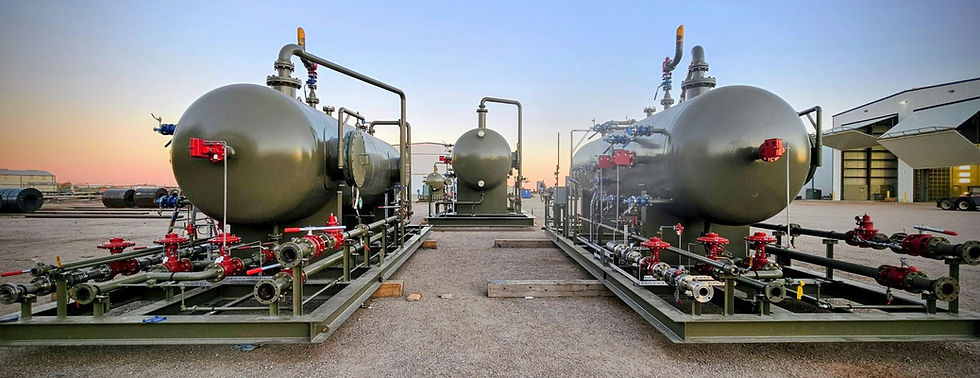Transporting Oversized Equipment for Oil and Utility: What It Takes
- mwolverton3
- Jul 2
- 4 min read

Transporting oversized equipment for the oil and utility industries is no small task. Whether it’s a pressure vessel for a gas processing facility or a steel transmission structure for a power substation, these components are massive, heavy, and often highly sensitive. A single delivery may span multiple states, require specialized rigging, and involve coordination with multiple regulatory agencies.
At Smith Industries, transporting oversized equipment is a core part of what we do. Our in-house transportation services help clients avoid delays and gain confidence that their project-critical components will arrive on time and in perfect condition. This article breaks down what goes into oversized transport and how our approach supports successful field execution.
What Qualifies as Oversized Equipment?
In the logistics world, any load that exceeds the standard legal size or weight limits for transport is considered “oversized.” According to the U.S. Department of Transportation, a load generally qualifies as oversized if it exceeds the following:
Width: 8 feet 5 inches
Height: 13 feet 5 inches (varies by state)
Length: 53 feet (for trailers)
Weight: 80,000 pounds gross (without special permits)
For oil and utility projects, this often includes:
ASME pressure vessels
Storage tanks
Pre-assembled skids
Substation frames
Transmission poles and cross-arms
Many of these components are both oversized and overweight, which means they require highly detailed route planning, permitting, and transport equipment.
Route Planning and Permitting
Transporting oversized equipment begins with a thorough planning phase. Our logistics team uses digital mapping tools and past project data to identify optimal routes. This step is crucial to avoid hazards like low-clearance bridges, sharp turns, and roadways that can’t support heavy loads.
Each state has its own permitting requirements for oversized loads. Our team works with departments of transportation across the U.S. to acquire:
Oversize load permits
Trip permits for out-of-state operations
Escort vehicle arrangements
Route surveys and bridge clearances
Depending on the size and weight of the equipment, these permits may also come with restrictions on travel times, such as only moving during daylight hours or avoiding rush-hour periods.
Specialized Equipment for Oversized Hauls
Standard flatbed trailers are not equipped to handle the types of vessels, tanks, or structural steel Smith Industries produces. We deploy a range of specialized trailers and lifting equipment designed for this level of transport.
Common Trailer Types:
Lowboys and drop decks: For taller components that require lower travel height
Extendable trailers: For extra-long skids or modular systems
Multi-axle trailers: To distribute heavy loads across more axles and avoid pavement damage
Hydraulic platform trailers (SPMTs): For loads that must be transferred onsite without cranes
These trailers are paired with cranes and rigging equipment on both ends of the trip to load, secure, and offload each piece with care.
Safety First: Securing the Load
Transporting oversized equipment is not just about size; it’s about risk. Loads must be secured with precision to prevent movement or imbalance during transit.
Smith Industries follows industry best practices as outlined by organizations like the Commercial Vehicle Safety Alliance and the Federal Motor Carrier Safety Administration. This includes:
Load-rated chains and binders
Corner protection for fragile edges
Redundant tie-down systems
Regular inspection of load security during stops
Drivers are also trained to follow safety guidelines specific to each route, especially when navigating narrow roads, steep grades, or inclement weather.
Coordinating with Project Schedules
Oil and utility projects are often scheduled down to the day. One delayed delivery can put field crews on standby and push back critical path items. That is why Smith Industries handles oversized transportation in-house rather than outsourcing to third-party haulers.
Our transportation division works directly with project managers to:
Time deliveries to match erection and installation schedules
Avoid double-handling of equipment
Adapt delivery timing to account for weather or jobsite readiness
Stage deliveries for sequential installation in modular builds
This integration helps reduce idle time and avoids costly rescheduling of cranes and crews.
Supporting Remote and Rural Sites
Many oilfield and utility projects are located far from major interstates. Smith Industries has years of experience navigating remote access roads, dirt trails, and rural rights-of-way to reach destinations that most transport providers cannot.
We assess ground conditions, slope stability, turning radius, and even local permit availability to finalize the logistics plan. When needed, we coordinate with civil contractors to prep temporary access roads or crane pads before equipment arrives.
The Smith Industries Difference
When it comes to transporting oversized equipment for oil and utility work, Smith Industries offers more than just trailers and trucks. We provide complete logistical support, direct coordination with your project team, and the peace of mind that your equipment will arrive intact and on schedule.
By handling transport internally, we reduce complexity, improve accountability, and maintain full control over the equipment’s condition from our shop floor to your jobsite.
Conclusion
Transporting oversized equipment for oil and utility projects requires more than moving large items. It’s a technical operation involving regulation, engineering, safety, and precision scheduling. Whether delivering pressure vessels, transmission components, or structural skids, Smith Industries manages the full scope of oversized logistics with the same dedication we bring to fabrication.
From route planning to rigging, we take pride in doing things the right way because when projects depend on your delivery, there is no room for shortcuts.




Comments